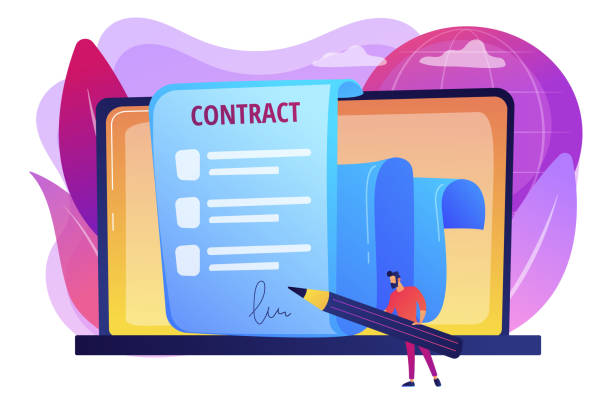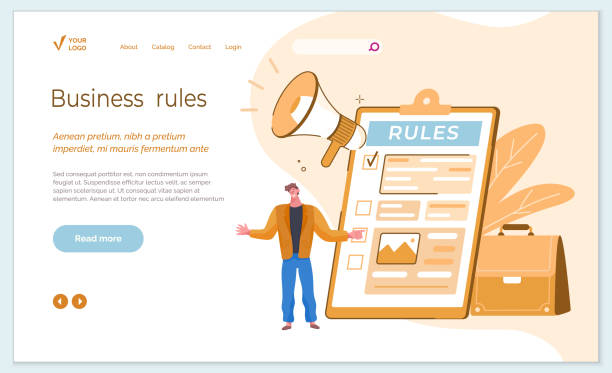Introduction to Responsive Web Design and its Importance in Today’s World

In today’s fast-paced digital world, #responsive_web_design is no longer a luxury option, but an undeniable necessity for every business and website.
With the increasing number of smartphone and tablet users, websites must be able to provide a seamless and optimized user experience on any screen size.
#Responsive_design does exactly that; it allows your website to intelligently adapt to the user’s device screen size and orientation.
This adaptability not only helps improve user experience, but also plays a vital role in search engine optimization (SEO).
Google and other search engines prefer responsive websites over those that are not optimized for mobile, and this prioritization directly impacts your search ranking.
The goal of this chapter is to provide a comprehensive and educational explanation of the concept and reasons behind the importance of responsive web design.
We will explore how a website can adapt to different devices and why this flexibility is essential for a successful presence on the modern web.
This approach lays the foundation for building an efficient and future-proof website that can keep pace with continuous changes in technology and user habits.
Tired of losing business opportunities due to not having a professional corporate website? Don’t worry anymore! With RasaWeb’s corporate website design services:
✅ Your brand’s credibility and professionalism will increase.
✅ You will attract more customers and sales leads.
⚡ Get a free consultation now to get started!
The Evolution of the Web and the Emergence of the Need for Responsive Design

The history of the web is full of change and evolution.
In the past, websites were primarily designed for display on desktop monitors, and the variety of screen sizes was limited.
However, with the #mobile_technology_explosion and the introduction of smartphones and tablets, websites suddenly faced a new challenge: how to display content on much smaller screens with touch capabilities? This historical and newsworthy transformation paved the way for the emergence of responsive web design.
Global statistics show that a significant portion of internet traffic occurs via mobile devices, and this share continues to increase.
This change in user behavior highlighted the need for a new approach to web design that could provide an optimal user experience without the need to design separate versions for each device.
Before the advent of responsive design, temporary solutions such as separate mobile websites (m.website.com) were common, which led to increased development costs, maintenance, and SEO issues.
However, with the introduction of the concept of responsive web design by Ethan Marcotte in 2010, a new perspective emerged that was based on flexibility and adaptability.
This chapter #analyzes_this_trend and demonstrates how these changes in the digital ecosystem have transformed responsive web design into an industry standard, not just a fleeting trend.
Understanding this background significantly helps in a deeper comprehension of the importance and benefits of this approach.
Key Principles and Implementation Techniques of Responsive Design

The implementation of responsive web design is based on three fundamental principles: #Fluid_Grids, #Flexible_Images, and #Media_Queries.
Fluid grids mean that the website’s layout is defined using relative units like percentages (instead of pixels), so that the width of elements automatically adjusts to the screen’s width.
Flexible images also adjust their width using CSS to fit their parent container, preventing content overflow.
Finally, media queries, which form the core of responsive design, allow developers to apply different CSS rules based on device characteristics (such as screen width, height, orientation, and resolution).
This section professionally and educationally explains each of these principles and demonstrates how to combine them to create a truly responsive website.
The choice of the Mobile-First approach is another key principle, where design starts from the smallest screen and then expands to larger devices.
This method ensures that the mobile experience is optimized and performs best.
Below is a comparative table of responsive design approaches:
| Feature | Mobile-First | Desktop-First |
|---|---|---|
| Design Starting Point | Smallest screen (mobile) | Largest screen (desktop) |
| Media Query Usage | min-width (from small to large) | max-width (from large to small) |
| Performance Priority | Highly optimized for mobile | May require more mobile optimization |
| Code Complexity | Simpler base code, adding more complex rules | More complex base code, fewer rules for smaller pages |
Innumerable Benefits of Responsive Website Design for Businesses and Users

Responsive web design is more than a design trend; it’s a strategic investment for any business seeking an effective online presence.
The first and most important benefit is improved #user_experience.
When your website is displayed correctly on any device, users can access content, navigate, and interact with the website without any issues.
This leads to a reduction in #bounce_rate and an increase in #conversion_rate.
Secondly, responsive web design has a significant impact on SEO.
Google has explicitly stated that it prefers responsive websites in its search results because they have a single URL for all devices, which makes crawling and indexing easier for search engines.
This means that a responsive website can achieve a higher ranking in search results.
Economically, #responsive_design is more cost-effective than developing and maintaining multiple separate versions of a website.
With a single codebase, initial development, updates, and maintenance costs are significantly reduced.
This section guides and explains these benefits in detail, demonstrating how a responsive website can contribute to the sustainable growth of your business, while also showcasing your commitment to providing the best user experience.
All these factors combined have made responsive design an essential standard in the field of web design.
Do you have an e-commerce site but your sales aren’t as expected? RasaWeb solves your problem permanently with professional e-commerce website design!
✅ Significant increase in conversion rates and sales
✅ Unparalleled user experience for your customers
⚡ Click here to get a free consultation with RasaWeb!
Challenges and Solutions for Overcoming Them in Responsive Design

Despite its many advantages, #responsive_web_design is not without challenges.
One of the most important challenges is #website_performance_management.
Loading high-resolution images and heavy scripts on mobile devices with poor internet connections can lead to slow loading speeds and a poor user experience.
The solution to this challenge is precise image optimization, using lazy loading for off-screen content, and code compression.
Another challenge is the #complexity_of_testing and debugging.
Since a website must be displayed correctly across a wide range of devices, browsers, and screen sizes, the testing process becomes very time-consuming and complex.
Using browser emulators, testing on real devices, and browser developer tools helps overcome this challenge.
Furthermore, #content_management for different devices can be questionable.
How much content should be displayed in the mobile version? How can navigation be optimized on smaller screens? This section addresses these challenges with thought-provoking and analytical content, providing practical and specialized solutions for overcoming them.
The discussion about how #responsive_design can improve user experience without sacrificing performance is of paramount importance.
Understanding these challenges and being prepared to tackle them is key to successfully implementing a sustainable and efficient responsive web design.
With careful planning and the use of best practices, the full potential of responsive design can be harnessed.
Popular Tools and Frameworks for Responsive Design

Web developers rely on a set of tools and frameworks to efficiently implement #responsive_web_design, which accelerate and standardize the process.
One of the most well-known of these frameworks is Bootstrap, which provides a comprehensive set of CSS and JavaScript for building responsive user interfaces.
Bootstrap, with its 12-column grid system, makes building complex yet responsive layouts very easy.
Foundation is another popular framework used for rapid development of responsive websites and web applications, with a strong emphasis on customizability.
Alongside these frameworks, #CSS_Grid and #Flexbox, as powerful CSS3 modules, have revolutionized how elements are laid out on web pages.
Flexbox is designed for arranging elements in one dimension (row or column), and CSS Grid for arranging in two dimensions (rows and columns), providing unparalleled control over responsive layout.
This section professionally and guidingly introduces these tools and explains how to use them to simplify the responsive web design process.
Choosing the right tool depends on project needs and developer preferences, but familiarity with these technologies is essential for anyone working in responsive design.
By using these tools, websites can be built that are not only beautiful but also have high performance and compatibility across all devices.
Best Practices for Image Management in Responsive Design

One of the most important aspects of #responsive_web_design, often overlooked, is proper image management.
Images can significantly impact loading speed and overall website performance, especially on mobile devices.
The goal of this section is to provide #expert_guidance for optimizing and delivering images responsively.
Using the <picture> tag is one of the most powerful methods, allowing you to define multiple image sources for different screen sizes.
The browser automatically selects the most suitable image based on the user’s device characteristics.
The `srcset` attribute in the `` tag is another method for providing images with different resolutions, allowing the browser to select the appropriate image based on the device’s pixel density (DPR).
Additionally, using modern image formats like #WebP, which have smaller file sizes and offer acceptable quality, is highly recommended.
#Lazy_Loading is also a crucial technique where images are loaded only when they enter the user’s viewport, which significantly increases the initial page loading speed.
Finally, image compression without a noticeable reduction in quality should be an integral part of the #responsive_design_process.
This section educationally and professionally details these techniques to ensure that your website not only looks good on all devices but also performs optimally.
Below is a table of image optimization techniques for responsive websites:
| Technique | Description | Main Benefit |
|---|---|---|
<picture> tag |
Providing different images for various media queries | Precise control over image sources based on device |
srcset attribute in <img> |
Defining multiple image sources with different resolutions | Automatic loading of appropriate image based on DPR and display size |
| WebP format | Modern image format with high compression | Significant reduction in file size without noticeable quality loss |
| Lazy Loading | Loading images only when they enter the Viewport | Increased initial page loading speed and improved performance |
| Compression and optimization | Using tools to reduce image file size | Reduced loading time, reduced bandwidth consumption |
Responsive Typography and Navigation: Key to a Flawless User Experience

Simply having a responsive website layout is not enough; #typography and #navigation_system must also be designed to be readable and usable on any device.
#Responsive_web_design requires special attention to font sizes, line heights, and character spacing to ensure text remains readable on smaller screens.
Using relative units like `em`, `rem`, or `vw` for font size, instead of pixels, allows for automatic text scaling.
The goal of this section is to provide education and explanation on how to achieve responsive typography and navigation.
Regarding navigation, extensive desktop menus should be converted to a more compact format, such as a #hamburger_menu, on mobile devices to save screen space while keeping all navigation options accessible.
Ensuring that clickable elements (such as buttons and links) are large enough to be easily tapped with a finger is an important principle in responsive website design.
Furthermore, the logical order of content on different devices, especially when changing screen orientation, is of great importance.
These principles help improve #usability and increase user satisfaction.
A responsive web design that pays attention to typography and navigation details is not only visually appealing but also provides a smooth and enjoyable user experience across all platforms.
This approach ensures that users, regardless of their device type, can easily engage with your content.
Are you concerned about your e-commerce site’s low conversion rate and not achieving your desired sales?
RasaWeb is your specialized solution for having a successful e-commerce site.
✅ Significant increase in conversion rates and sales
✅ Professional and user-friendly design to attract customer satisfaction
⚡ Ready for a transformation in online sales? Get a free consultation!
Testing and Debugging Responsive Websites

After implementing #responsive_web_design, the crucial stage of #testing and #debugging arrives.
This stage ensures that your website functions correctly across all devices, browsers, and screen sizes, providing a seamless user experience.
#Manual_testing on real devices, though time-consuming, is essential because emulators cannot reproduce all functional and interactive differences of real devices.
Browser developer tools like Chrome DevTools or Firefox Developer Tools provide the ability to simulate different screen sizes and mobile device modes, helping to quickly identify layout issues.
Furthermore, online tools like #Responsinator or #BrowserStack allow you to test your website in various simulated environments.
In the #specialized and guiding section of this chapter, we comprehensively examine these tools and testing methods.
One important point is testing the touch functionality of elements, ensuring correct mobile navigation performance, and checking loading speed across different networks (2G, 3G, 4G).
Also, it should be noted that #responsive_design is not limited to visual layout; functional aspects such as scripts and interactions must also be considered to ensure optimal performance on all devices.
A regular and comprehensive testing process is key to successfully delivering a high-quality responsive web design that meets user needs and is technically stable.
Neglecting this stage can lead to a poor user experience and damage brand reputation.
The Future of Responsive Design and New Trends in Web Development

The world of web is constantly changing and evolving, and #responsive_web_design is no exception.
While #responsive_design remains a golden standard, new trends and advanced technologies are emerging that are shaping the future of web development.
One of these trends is #Progressive_Web_Applications (PWA), which offer a combination of the best features of web and native applications; these applications can be installed on the home screen, work offline, and send notifications.
Another is Adaptive Design, where the website is designed for specific, predefined breakpoints rather than reacting to continuous changes.
This approach can, in some cases, provide more control over content and performance.
Also, the emergence of #new_browser_APIs and increased processing power of devices has provided new possibilities for #modern_web_design.
This section analytically and engagingly examines these future trends and demonstrates how responsive web design serves as a strong foundation for these innovations.
The discussion about the future of user interaction with the web, including voice user interfaces and augmented reality, outlines exciting prospects for web developers and designers.
Being prepared for these changes and continuously updating knowledge in the field of #responsive_design will be key to success in the dynamic world of the web.
Frequently Asked Questions
| Question | Answer |
|---|---|
| What is Responsive Web Design? | It is a web design approach that ensures web pages display correctly and readably across various devices and screen sizes (such as desktop, tablet, and mobile). |
| Why is Responsive Web Design important? | Improved user experience across different devices, higher rankings in search engines (SEO), and saving time and cost compared to building separate mobile or tablet versions. |
| What technologies are used in Responsive Design? | The main technologies include HTML for structure, CSS for styling (especially Media Queries), and the use of flexible images and grids. |
| What is a Media Query? | A Media Query is a CSS technique that allows applying different styles based on the characteristics of the device the user is using (such as screen width, orientation, and resolution). |
| What is the concept of Mobile First in Responsive Design? | It means starting the design and development of a website first for mobile devices with small screens, and then scaling it up for larger devices (such as tablets and desktops). This method ensures a focus on user experience on smaller devices. |
And other services of RasaWeb Advertising Agency in the field of advertising
The importance of providing installation and setup services in ads
Review of comparative methods in manufacturers’ ads
Increasing sales using repetitive advertising in ads
The role of logo design in attracting attention to manufacturers’ classified ads
Review of the impact of color and font in the design of classified ads
And over hundreds of other services in the field of online advertising, advertising consultation, and organizational solutions
Online Advertising | Advertising Strategy | Advertorial
🚀 Ready to take your business to the peak in the digital world? RasaWeb Afarin Digital Marketing Agency, with its expert and creative team, is always by your side to pave your path to success with innovative strategies and comprehensive services. From SEO and optimization to professional e-commerce website design, we are here to turn your digital dreams into reality.
📍 Tehran, Mirdamad Street, Next to Central Bank, Southern Kazeroun Alley, Ramin Alley No. 6

